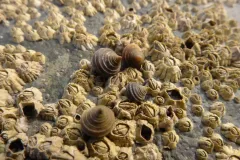Spirals in Time: A Walk at the Seashore

When I set out to write a book about mollusks (called Spirals in Time), I wasn't quite prepared for just how many animals I would get to know. There are somewhere between 100,000 and 200,000 mollusk species alive today, from clams, cockles and conches to snails, nautiluses and argonauts. I knew I wouldn’t try to name check them all or build an encyclopedia of everything that‘s known about them. Instead, my book would attempt to answer why the mollusks are so wondrous and diverse.
I grew up exploring the wild, Atlantic-swashed shores of southwest England on family holidays. Back then, seashells (and their molluscan makers) were my favorite treasures to find. Now as a marine biologist, I lead students on field trips through these same rich marine ecosystems as we pick our way across boulders and splash through tide pools.
One reason why there are so many mollusks is they are immensely adaptable. They inhabit all manner of different habitats and nowhere is this more obvious than on a rocky shore. Making our way towards the sea, we step through distinct territories dominated by different mollusks that can cope with the shifting conditions of cold, dry air and salty, surging waves as the tide moves in and out. Up high where the sea barely reaches, common limpets (Patella vulgata) clamp tightly to rocks so that they don’t dry out. Earlier this year, scientists discovered that limpets make their teeth from the toughest known biological material (a mineral called goethite). Step aside spiders with your silk; here come the limpets. Super-strong teeth are essential for these animals that survive by scraping filmy seaweeds from rocks, leaving zigzag trails as they go.
Lower down the shore in the temporary isolation of tide pools, throngs of top shells gather, including grey and flat varieties (Gibbula cineraria and G. umbilicalis) and gem-like painted top shells (Calliostoma zizypthinum) with their perfectly conical homes decorated in pink spots. Other sea snails huddle in damp seclusion among seaweed fronds. Flat periwinkles (Littorina obtusata) have rounded shells, with colors that mimic the bulbous floats of bladder wrack (Fucus vesiculosus) and knotted wrack (Ascophyllum nodosum). In the spiral wrack (Fucus spiralis) we find rough periwinkles (Littorina saxatilis), which were recently noted as the most over-named species in the world. Biologists have unintentionally given these little gastropods more than a hundred different scientific names.
We time our beach-hunting forays to coincide with the falling spring tides. As we progress down the shore, the waves draw out ahead of us and briefly uncover the edges of the fully marine realm. Here, on the underside of rocks, we find mollusks called chitons that resemble colorful, flattened woodlice; in place of a single shell they have a series of overlapping plates down their backs.
I tell my students to peer into crevices to spot dog whelks (Nucella lapillus) with their finely twisted shells. These predators feed on other mollusks, including blue mussels (Mytilus edulis), by drilling holes in their shells, softening their insides with an enzyme cocktail, and sucking out the resulting soup with a long, straw-like proboscis. The immobile mussels can’t escape but they fight back, wrapping their attackers in sticky, stretchy fibers called byssus threads, which they typically use to attach themselves to wave-pounded rocks. Scientists are now tapping into the mussels’ sticking power to make waterproof glues and self-healing hip replacements.
At the lowest point we can reach, we wade to the tops of our wellington boots and crouch to see inside dripping mini-caves that are usually submerged. Inside lurk the porcelain humps of spotted cowrie shells (Trivia monacha). The cowries busily feed on sea squirts that grow like a layer of glistening jelly across the rocks. Nearby on the thick, rubbery stems of kelp, blue-rayed limpets (Patella pellucida) nestle inside holes that they chewed themselves. Their delicate stripes shine bright turquoise, a trick of the light that scientists have recently traced to the inner structure of their calcium carbonate shells. One day, we could be looking at the world through ‘augmented reality’ glass inspired by these small seashells.
There are plenty more mollusks to find in the open sea, but those are much harder to reach. I would love to show my students sea butterflies, the tiny sea snails with delicate, transparent shells that flit around on little wings. To see them we would need to venture offshore in a boat and tow a plankton net through the water. And if only the university would hire us a deep-sea submersible, we could venture down into the dark depths and find hydrothermal vents, miles beneath the waves, encrusted in snails and mussels.
But not today. Instead, the tide slowly pushes us back inland, with our heads full of mollusks and perhaps in our pockets a few empty shells.

